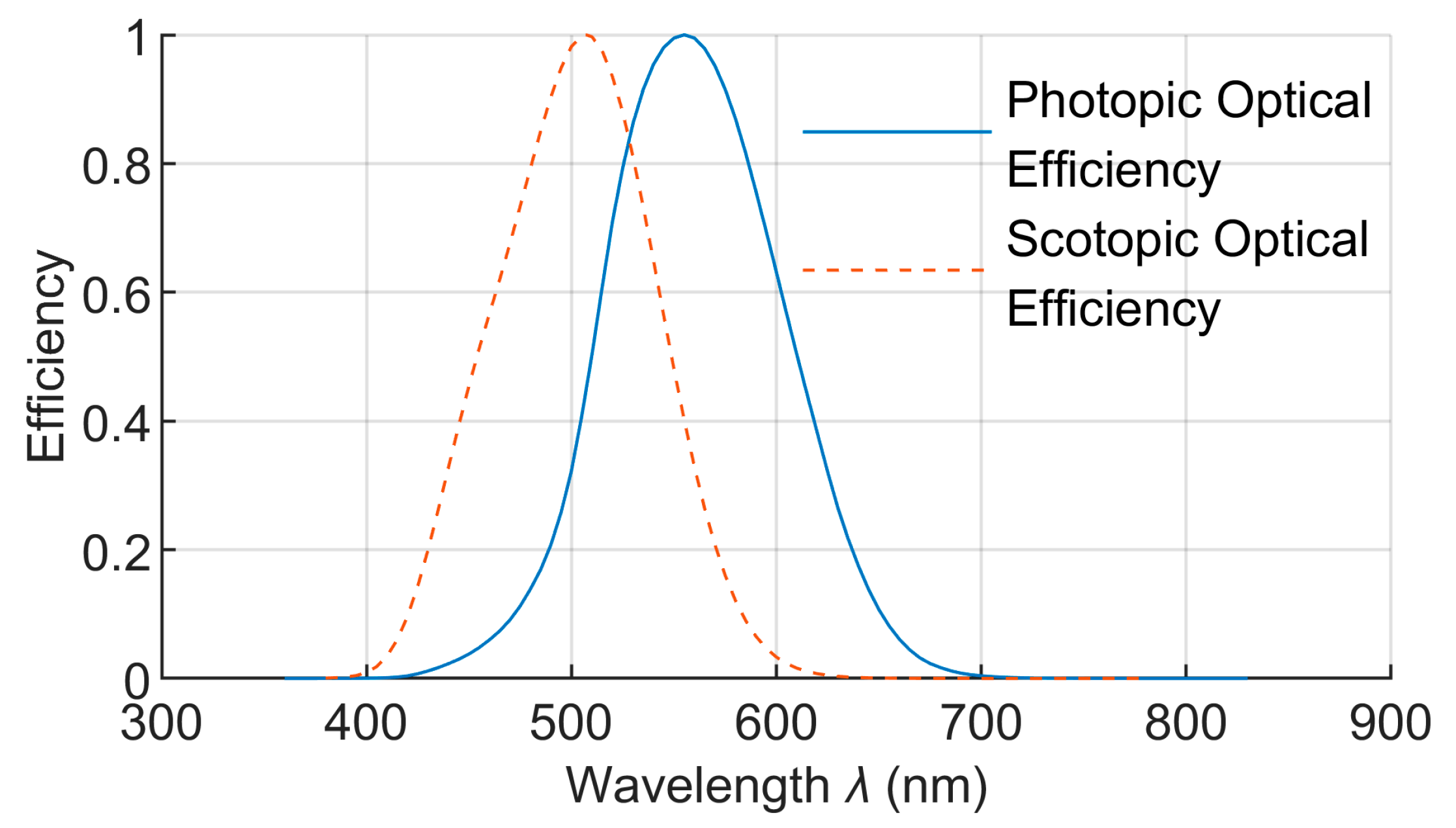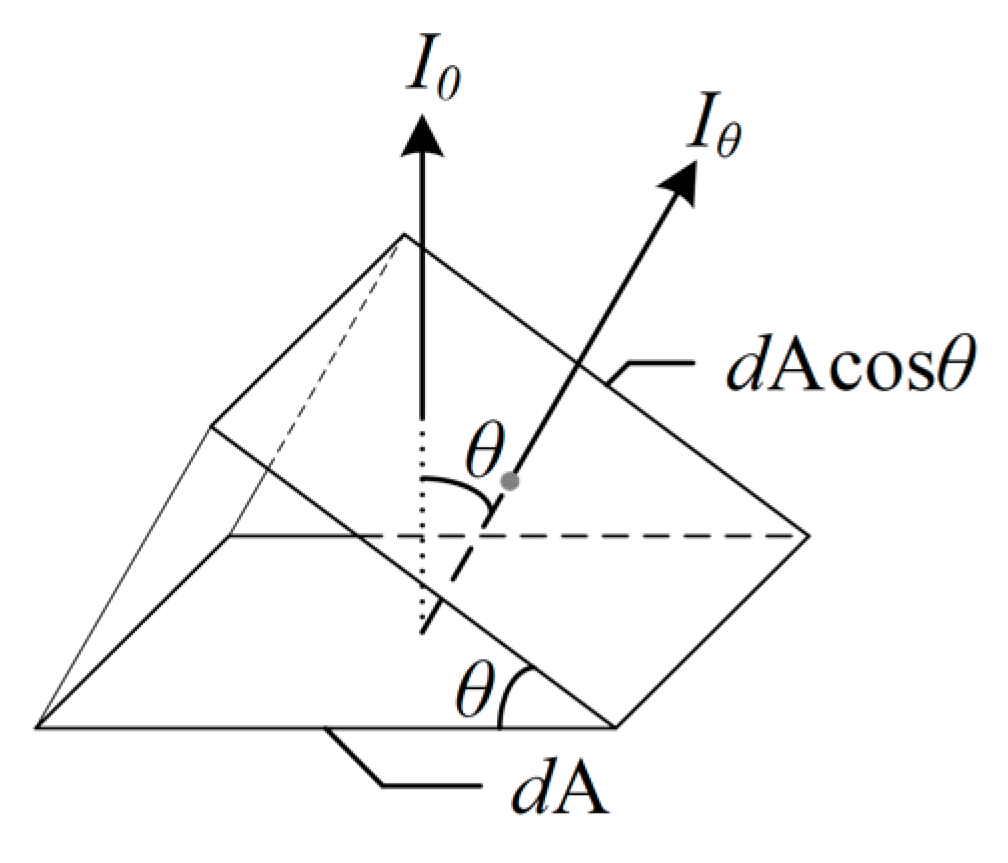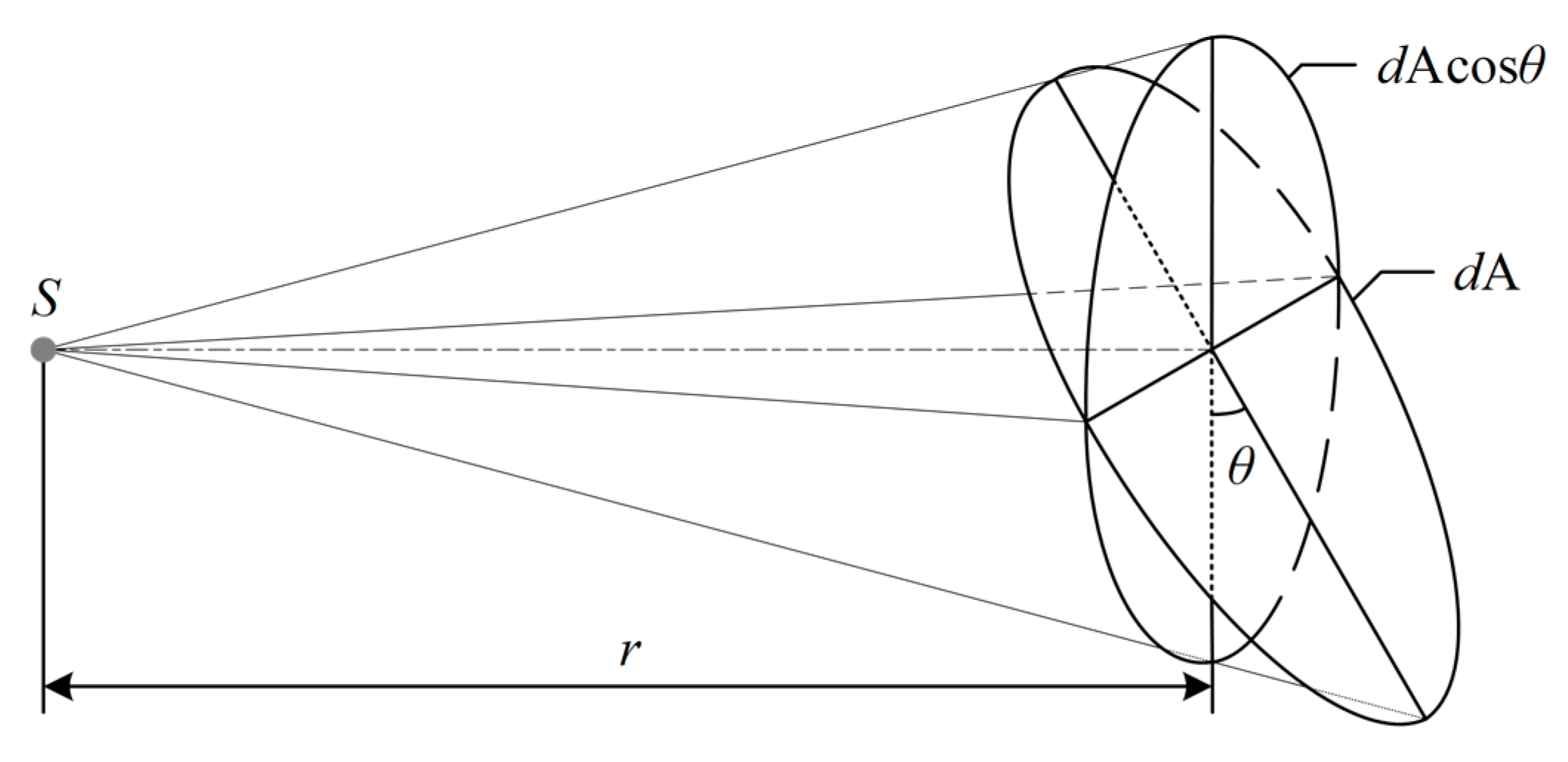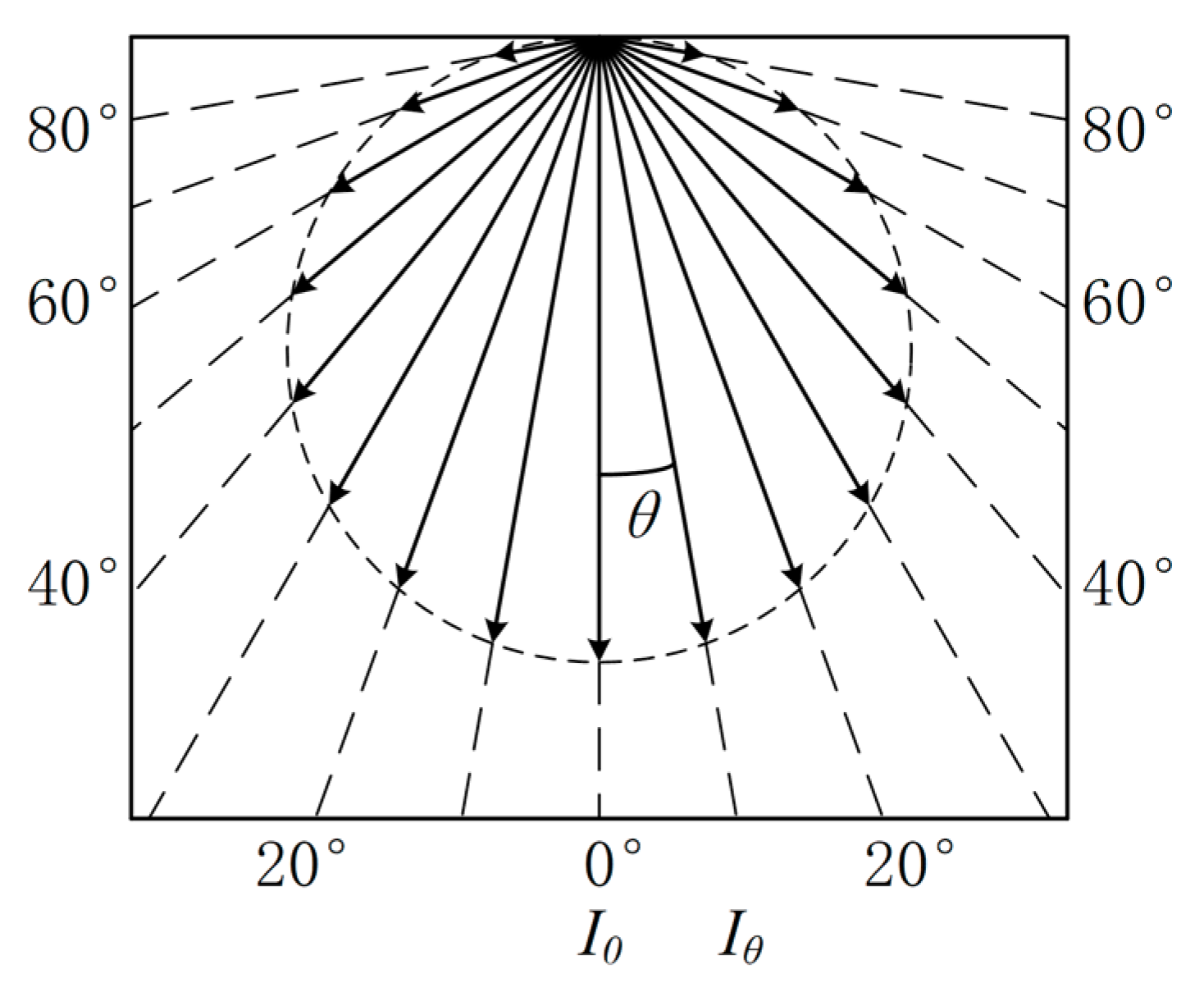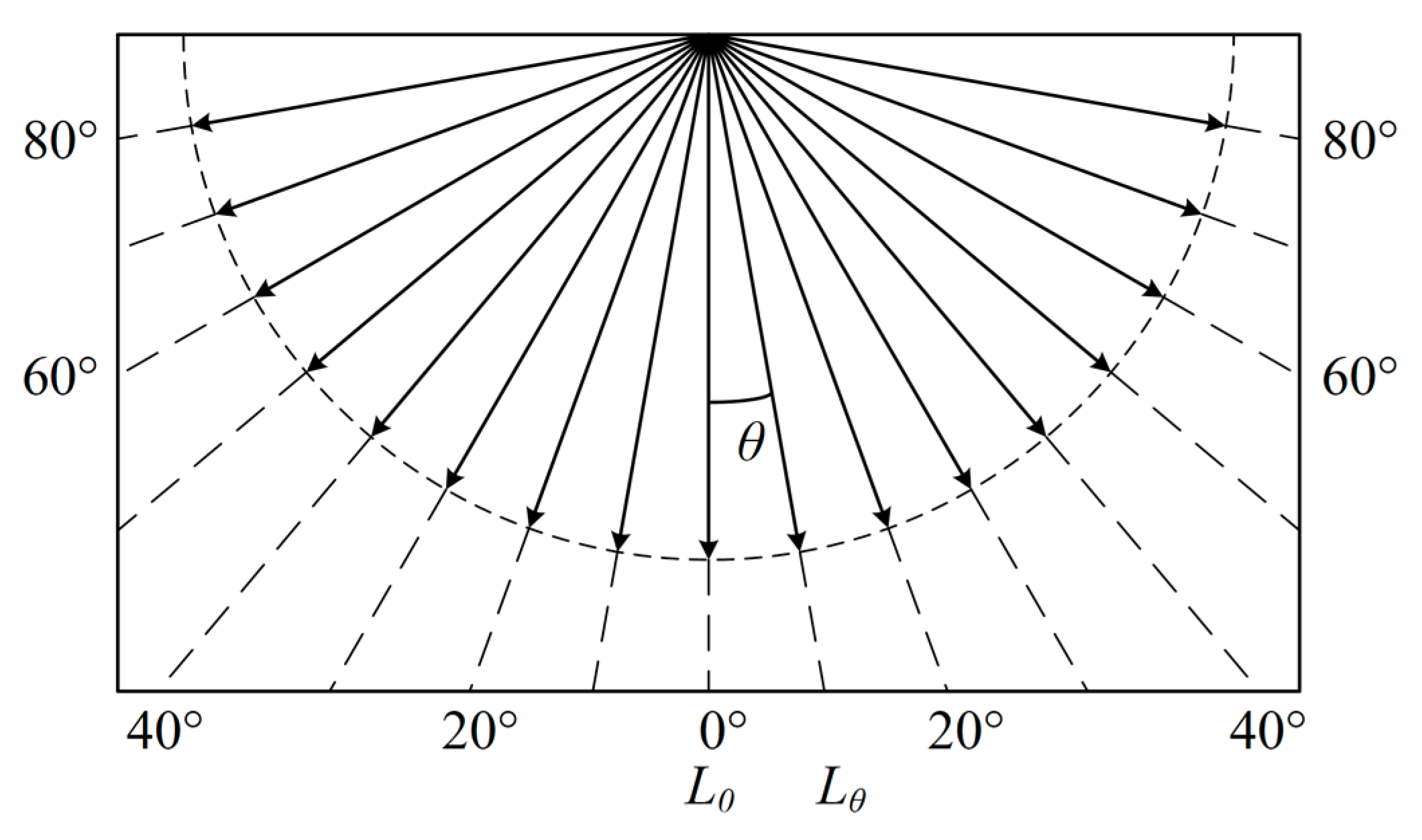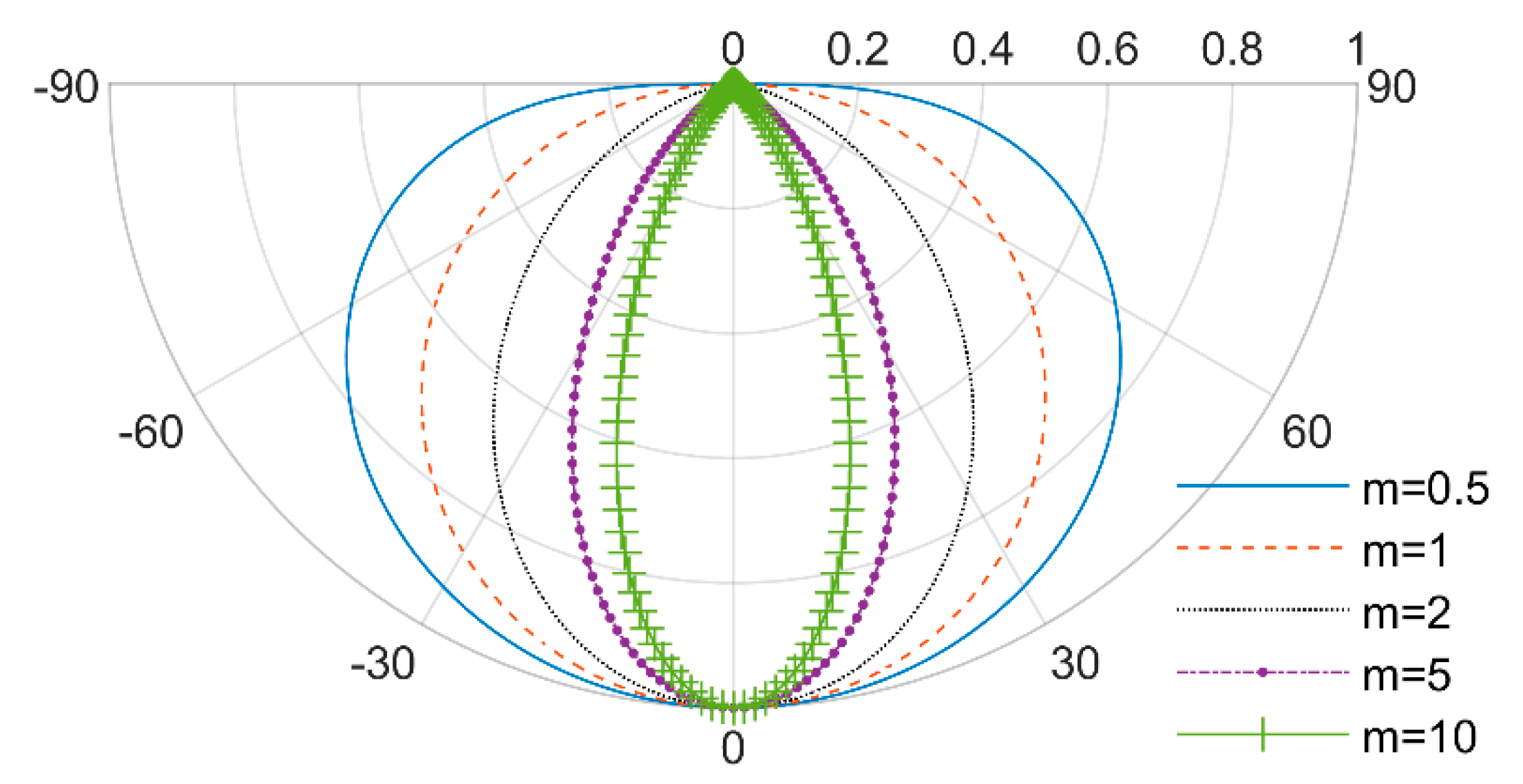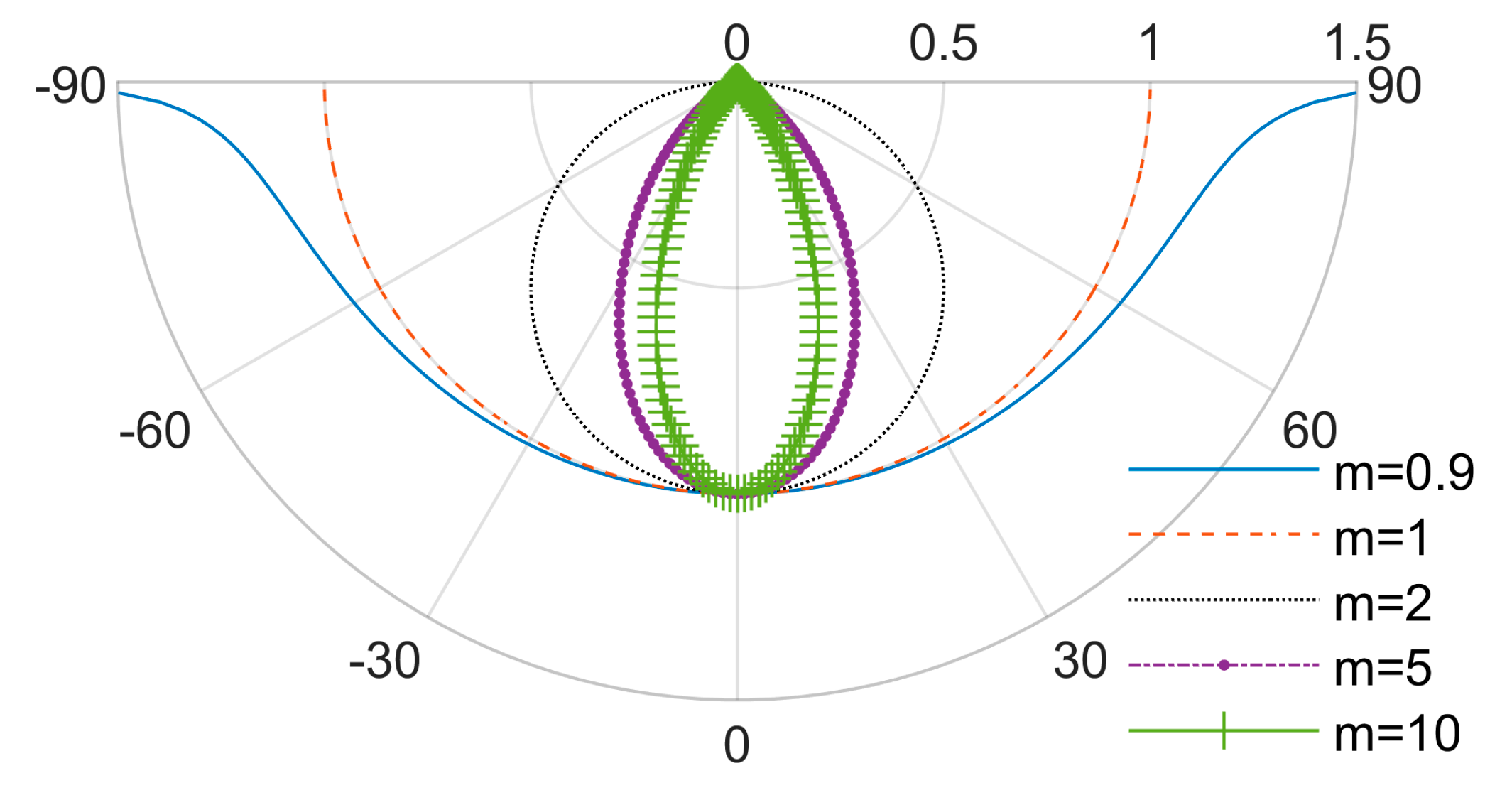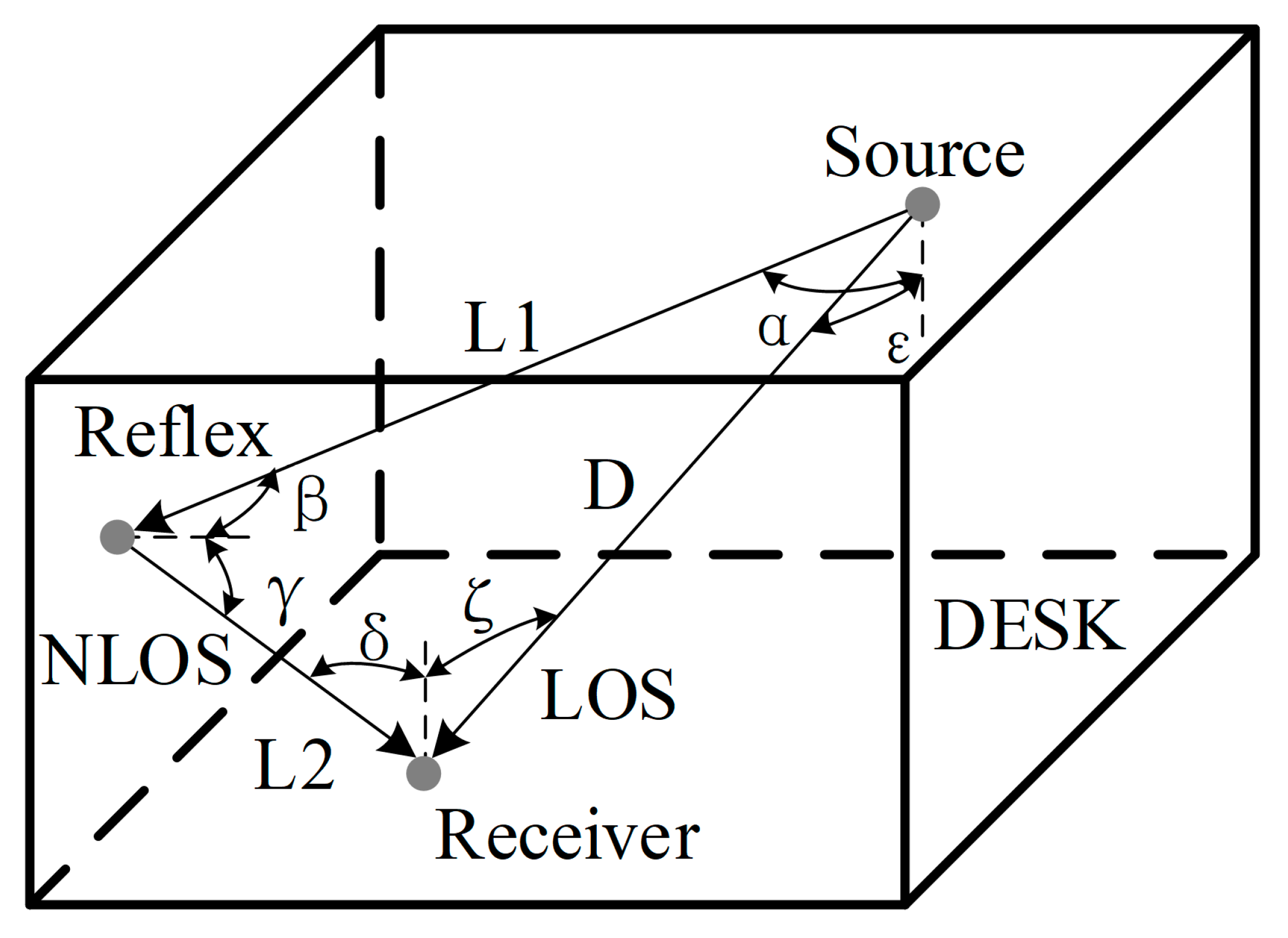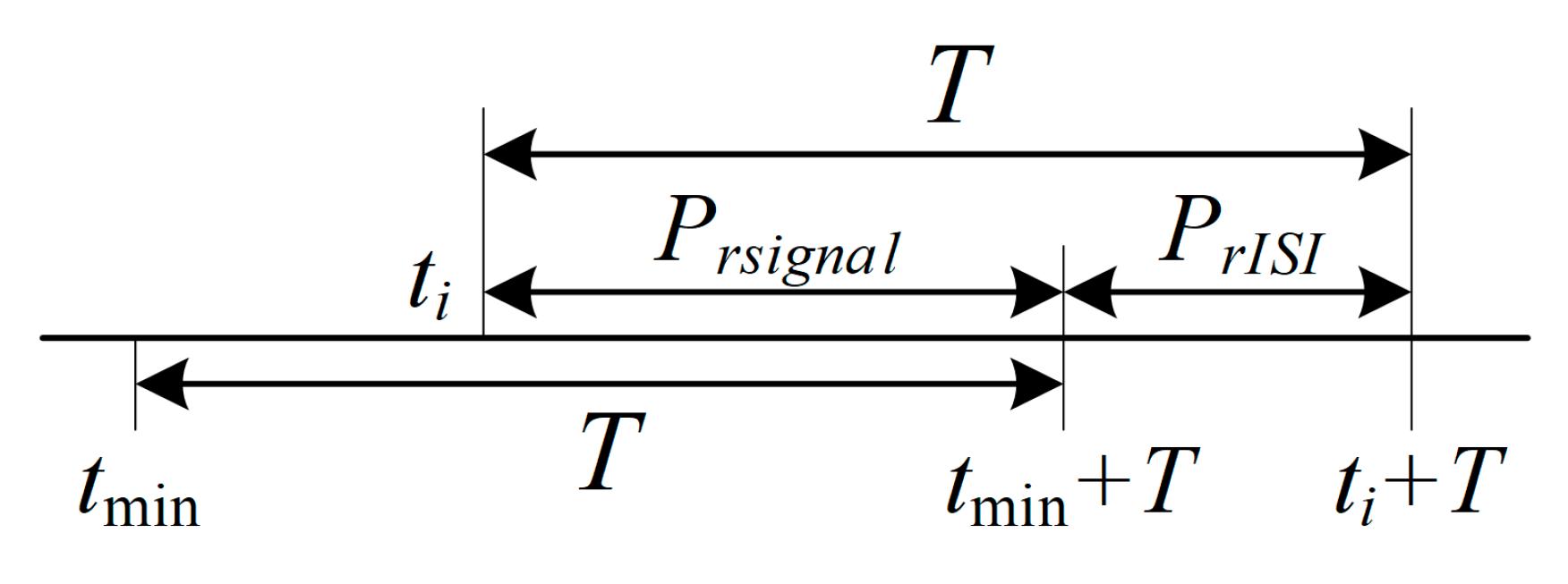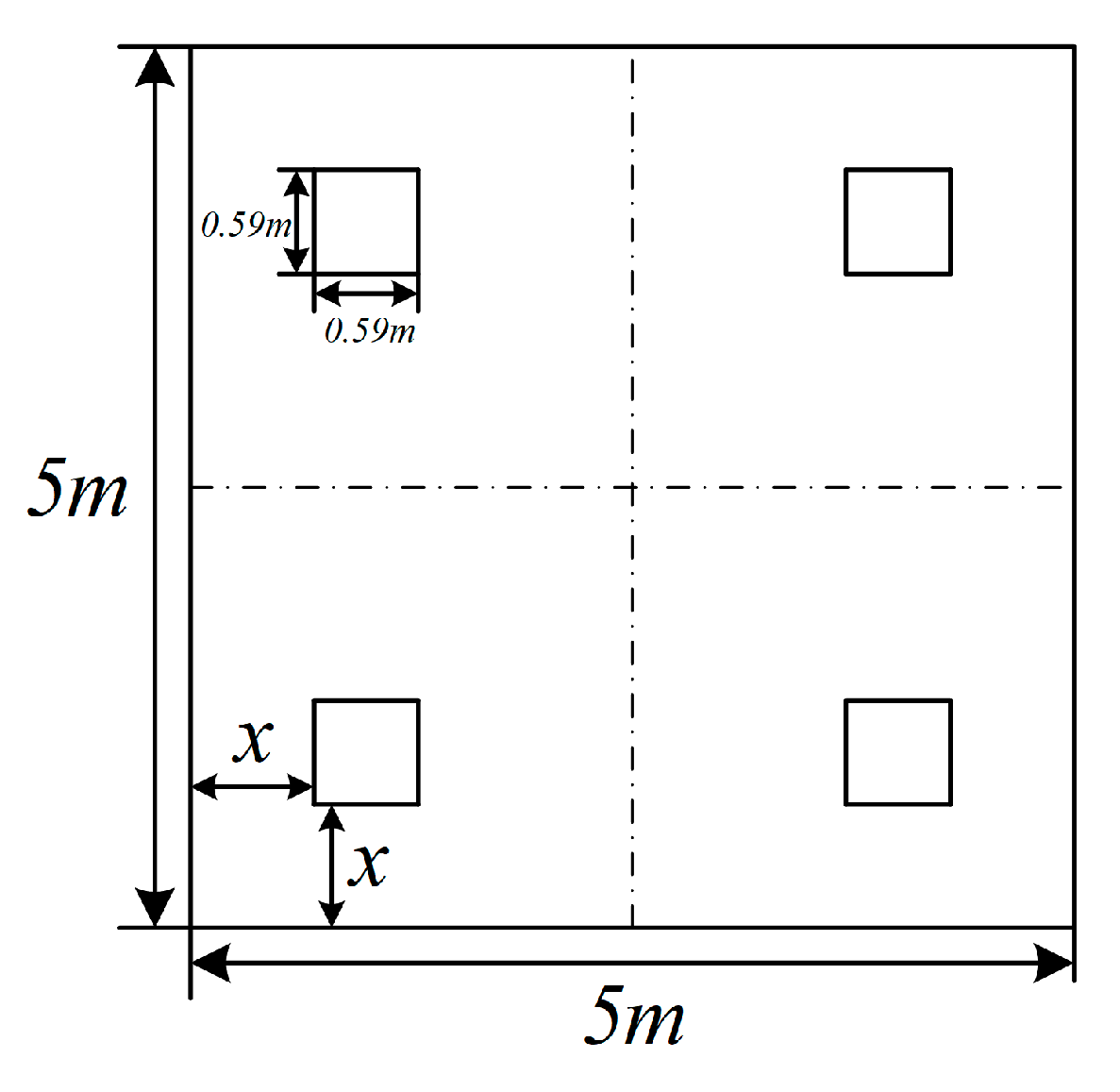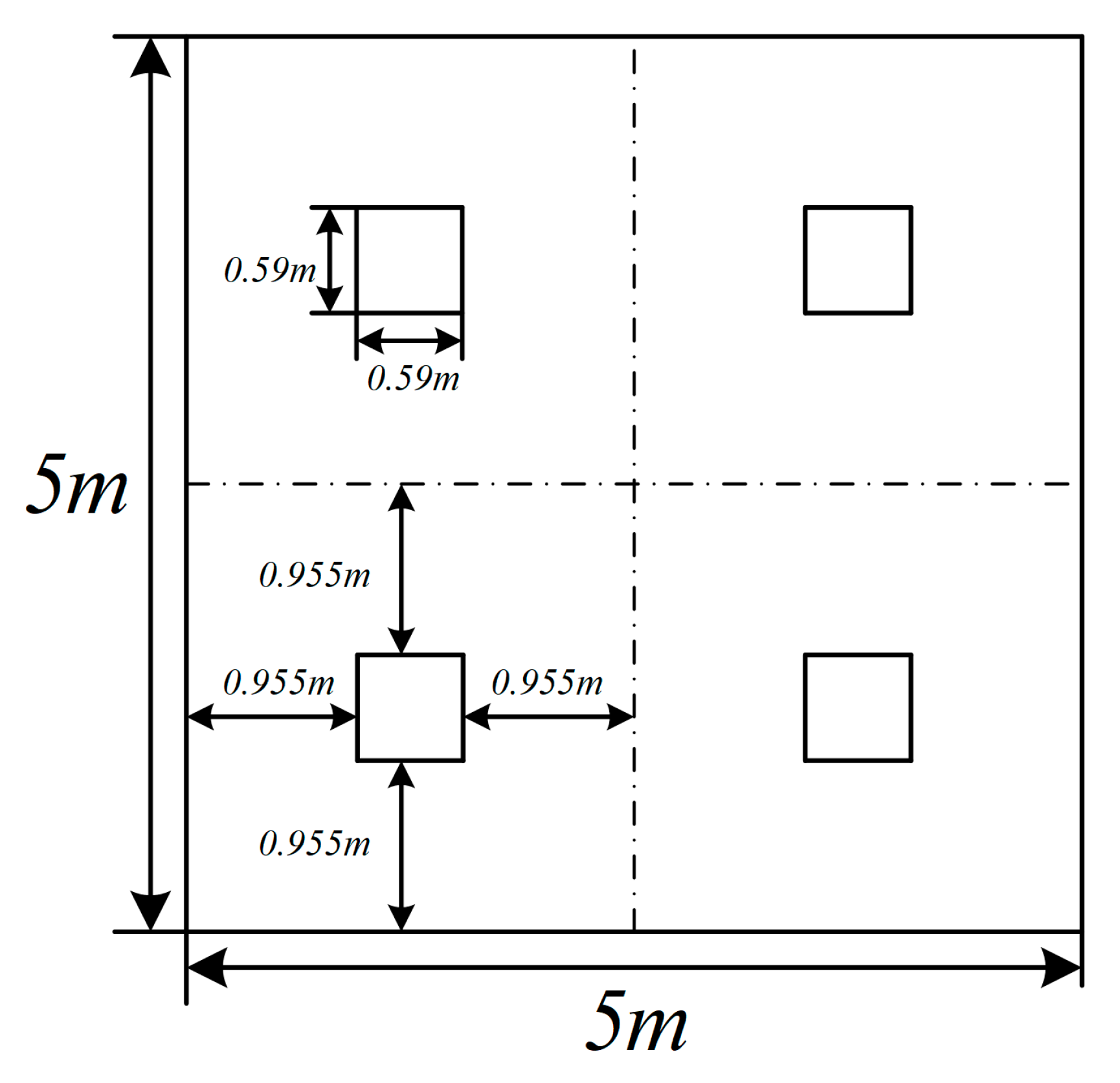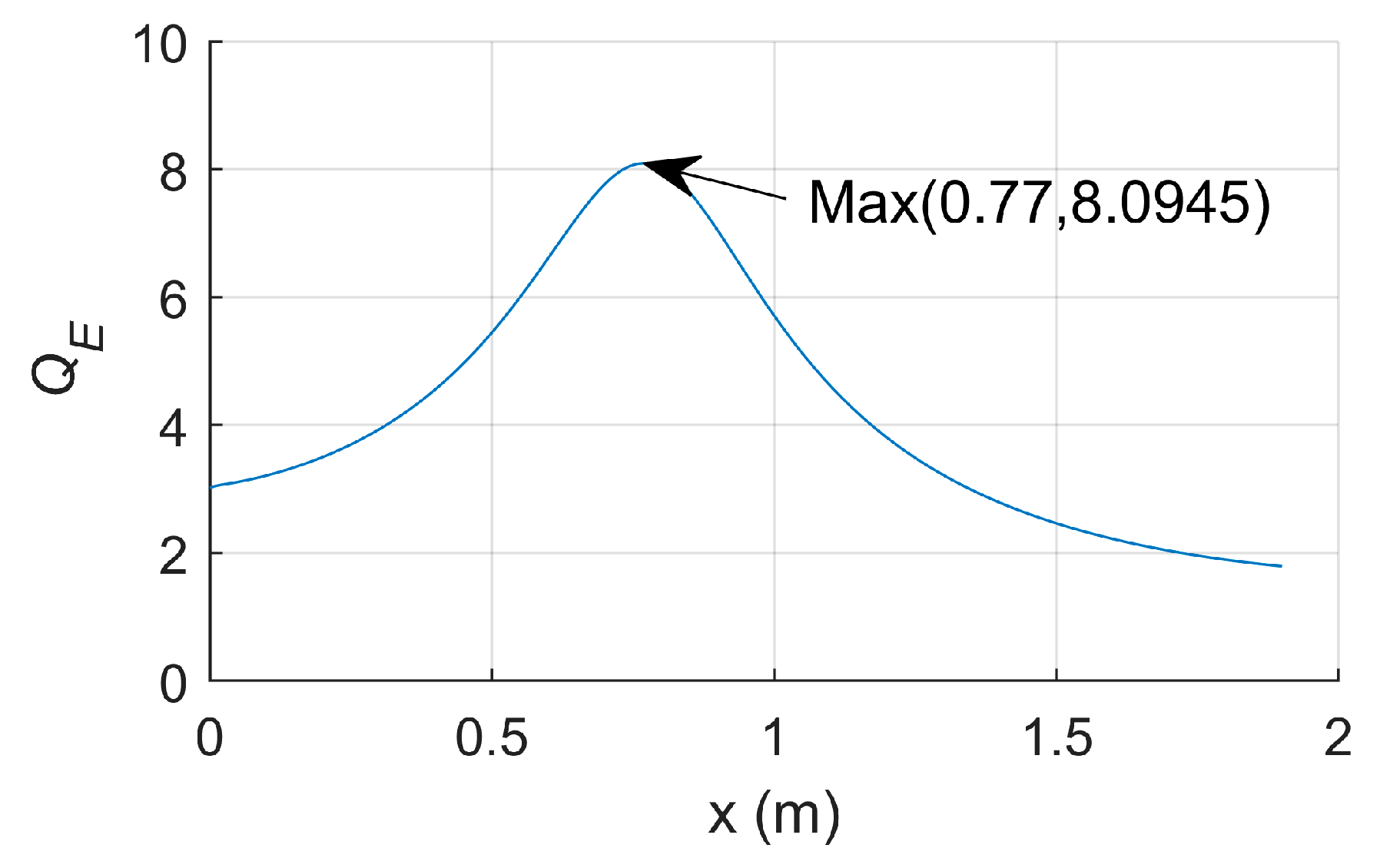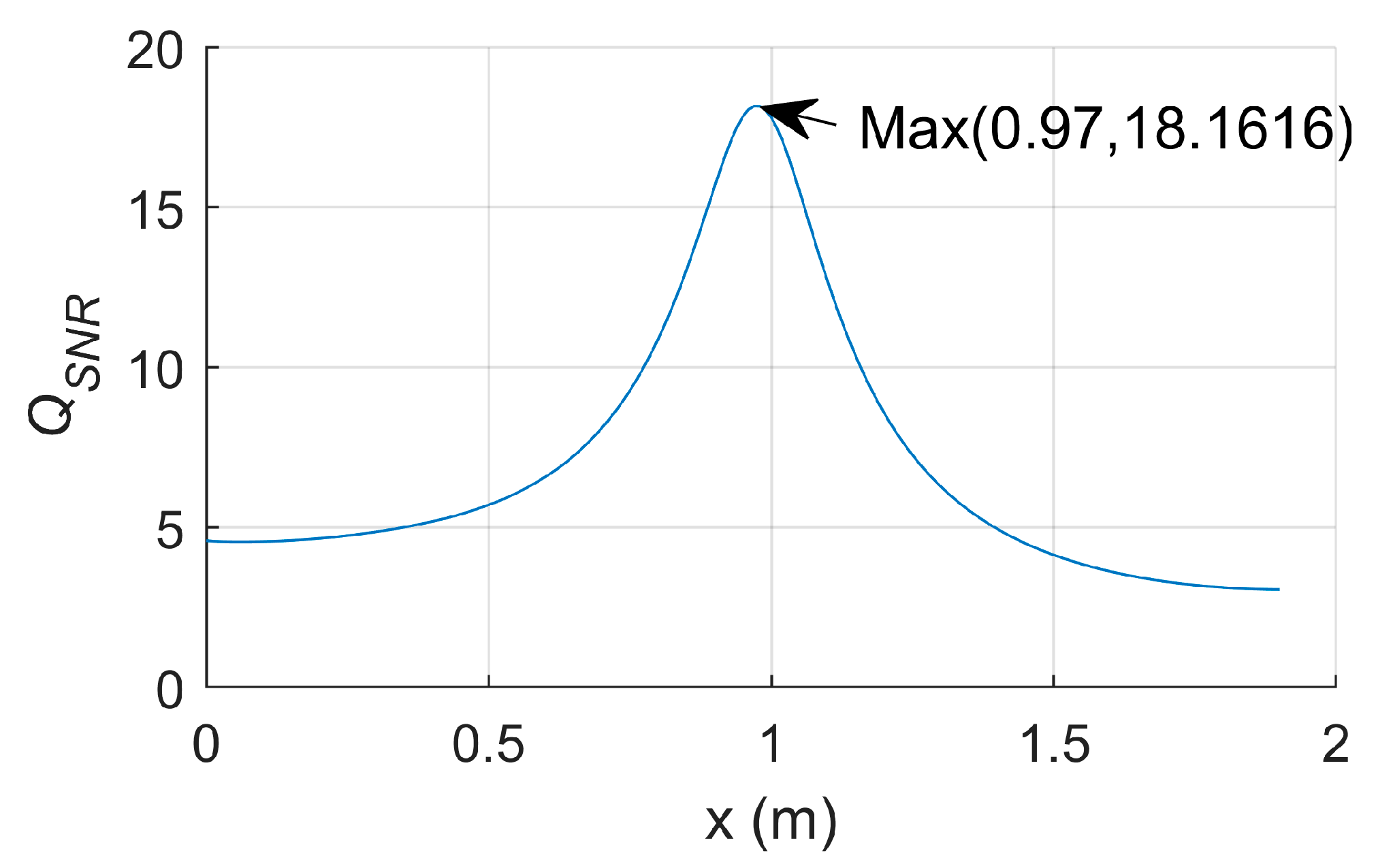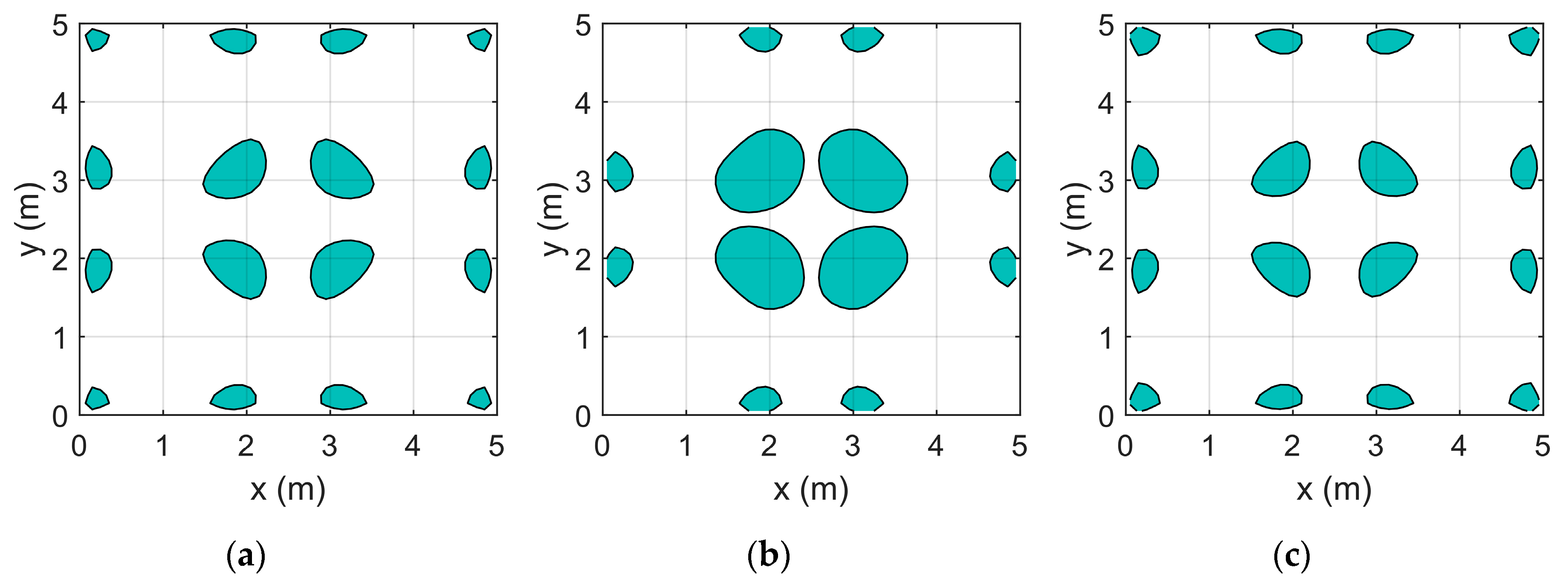1. Introduction
For an actual visible light communication (VLC) system, it is necessary to consider the uniformity of indoor illumination, so it is preferred to use light-emitting diodes (LEDs) with a larger half-power angle, which enhances the multipath effect while causing inter-symbol interference (ISI) and reducing the signal-to-noise ratio (SNR). In order to improve the performance of a VLC system, various optimization schemes have been proposed [
1,
2,
3,
4,
5].
An optimization scheme based on an evolutionary algorithm is proposed to modify the optical intensity of LED transmitters for reducing the signal power fluctuation extent [
1]. A new arrangement scheme of LED lamps is proposed, and the SNR fluctuation is reduced from 14.5 to 0.9 dB [
2]. A hybrid scheme that combines spotlighting with uniform lighting is proposed to achieve uniform illumination and high data rate [
3]. An optimization scheme based on light-shaping diffusers is proposed to achieve uniform power distribution [
4]. An optimization scheme based on the Lambertian order is proposed to improve the performance of a VLC system [
5].
According to published papers [
6,
7], it is necessary to consider the effect of the first reflected light, but most of the existing optimization schemes only consider the direct radiation, and the optimization results usually do not conform to the practical application conventions, which increase the actual cost and the complexity of system construction. In this paper, considering the first reflected light and based on the conventional layout model and the classic indoor VLC model, the normal layout, the optimal layout of illumination, and the optimal layout are simulated, and the relevant data are analyzed.
Following the introduction, this paper is organized in four sections. In
Section 2, the basic theories and calculation formulas of VLC simulation are shown. In
Section 3, the data and indoor environment used in the simulation are shown, the parameter
Q is defined, and the three layouts are determined. In
Section 4, the illuminance distribution, SNR distribution, maximum delay spread (M-DS) distribution, and impulse response (IR) of the three layouts are shown and analyzed. Finally, our conclusions are given in
Section 5.
2. Basic Theories of VLC
This section is divided into three parts, which respectively explain the basic theories and calculation formulas used in the simulation of illuminance, optical radiation power, and channel quality in VLC. In existing papers [
5,
6], it is assumed that the light source is a near-Lambertian light source and the reflective surface is a standard Lambertian surface. These two assumptions are used in this paper. Some basic photometric parameters are described below.
The basic physical quantity used in optical radiometry is the radiant flux or radiant power, symbolized by Φe in watts (W). Photometry is a discipline that studies the senses of human eyes. The units used are based on a physical basis and the characteristics of the human eye. Therefore, all units in photometry are artificial.
Luminous flux indicates the visual intensity of the human eye caused by radiant flux, which is the physical quantity derived from the radiant flux
Φe, that is, the photometric quantity of the radiant flux, based on the effect of the radiation on the standard photometric observer of the International Commission on illumination (CIE). Luminous flux is an intrinsic property of a light source. The symbol is
Φv and the unit is lumen (lm = cd·sr):
where
V(
λ) is the photopic optical efficiency function, as shown in
Figure 1;
Km is the photopic optical efficiency at
λ = 555 nm, and is also the maximum of
V(
λ), one of the photometric constants,
Km = 683 lm/W.
Luminous intensity indicates the illuminating characteristic of a light source in a given direction, which is defined as the magnitude of the luminous flux
Φv per unit solid angle
Ω in a given direction. The symbol is
Iv and the unit is candela (cd):
Luminance indicates the illuminating characteristic of the illuminating surface in a given position and direction, which is defined as the illuminating intensity
Iv per unit cross-section perpendicular to the direction. The symbol is
Lv and the unit is candela per square meter (cd/m
2):
where
dA is the surface element of the beam section;
θ is the angle between the normal of the surface element and the given direction, as shown in
Figure 2.
Illuminance indicates the light-receiving characteristic of the illuminated surface in a given position, which is defined as the luminous flux
Φv received on the unit tangent plane on the fixed point. The symbol is
Ev and the unit is lux (lx = cd·sr/m
2):
where
dA is the surface element of the tangent plane on the fixed point;
θ is the angle between the normal of the surface element and the direction from the fixed point to the point source;
r is the distance between the fixed point and the point source, as shown in
Figure 3.
The luminous intensity of a standard Lambertian source (standard Lambertian surface) conforms to the law of cosine, as shown in
Figure 4.
The luminous intensity
Iv,θ at a certain angle is equal to the light intensity
Iv,0 in the axial direction of the light source multiplied by the cosine of the direction angle:
From Equations (3) and (5), the luminance of a standard Lambertian source (standard Lambertian surface) is independent of the direction, as shown in
Figure 5:
Symbolizing the luminance of a standard Lambertian source as
Lv and the area as
dA, the total luminous flux
Φv radiated in the entire hemispherical surface, SP, is given in Equation (7):
Therefore, the luminous exitance
Mv and the luminance
Lv of a standard Lambertian source are in the following relationship:
In the LED industry, people use the half power angle θ1/2 as a measure of the angle of illumination. The half power angle θ1/2 is defined as the angle between the axial direction and the direction in which the luminous intensity is half with the axial direction. From Equation (5), the half power angle θ1/2 of the standard Lambertian source is 60°.
In practical applications, the LED half power angle
θ1/2 is often not equal to 60°. Such an LED is called a near-Lambertian light source, and the luminous intensity function is expressed as:
where
m is the order of the Lambertian source. Combined with the definition of the half power angle
θ1/2, the following is obtained:
So, we know that the order of the Lambertian source
m and the half power angle
θ1/2 correspond to each other. The order of the Lambertian source
m can be obtained by the half power angle
θ1/2, and the normalized luminous intensity distribution function curve is plotted, as shown in
Figure 6.
From Equations (3) and (9), the luminance of a near-Lambertian source is related to direction, and the normalized luminance distribution is shown in
Figure 7:
Figure 8 is a diagram of indoor VLC communication. We know that the indoor VLC communication links are divided into two categories: line of sight (LOS) and non-line of sight (NLOS). It has been proved that the proportion of the secondary reflected light to the total is too small [
6]. In this paper, only direct light and first reflected light are considered.
2.1. Horizontal Illuminance of LOS and NLOS
2.1.1. Horizontal Illuminance of LOS
From Equations (4) and (9), the horizontal illuminance of LOS,
Ev,LOS, is known:
where
I0 is the axial luminous intensity of LED lamps.
2.1.2. Horizontal Illuminance of NLOS
From Equation (12), the illuminance at the reflection point on the wall of NLOS,
Ev,NLOS,Ref, is known:
From Equation (13), the luminous emittance at the reflection point on the wall of NLOS,
Mv,NLOS,Ref, is known:
where
ρ is the reflectivity of the wall.
From Equations (3), (8) and (14), the luminous intensity in the normal direction at the reflection point of NLOS,
Iv,NLOS,Ref, is known:
where
dAWALL is the reflective area of a small region.
From Equations (4), (5) and (15), the horizontal illuminance of NLOS,
Ev,NLOS, is known:
2.2. Received Power of LOS and NLOS
Analogously to the definition of luminous intensity, in radiometry, the radiation intensity is defined as the radiant flux
Φe per unit solid angle
Ω in a given direction. The symbol is
Ie and the unit is watts per solid angle (W/sr):
Because luminous intensity and radiation intensity are descriptions of the same physical phenomenon from different aspects, according to Equation (9), the radiation intensity of a near-Lambertian source can be assumed as follows:
where
Vm is a variable associated with
m and determining the relationship between
Φe and
Ie.
For a single-sided LED, the total radiant flux
Φe radiated throughout the hemispherical surface SP can be calculated as:
From Equations (18) and (19), the radiant intensity
Ie is known:
2.2.1. Received Power of LOS
From Equations (1), (12) and (20), the received power of LOS, PLOS, is known [
6]:
where
AR is the physical area of the detector in a photo diode (PD);
PS is the transmitted optical power of the source;
TS(
ζ) is the gain of an optical filter;
Ψc is the width of the field of vision (FOV) at a receiver;
g(
ζ) is the gain of an optical concentrator.
g(
ζ) is known [
6], and is given in Equation (22):
where
n is the refractive index.
2.2.2. Received Power of NLOS
From Equations (1), (16) and (20), the received power of NLOS,
PNLOS, is known [
6]:
2.3. Channel Quality
Channel noise is divided into three parts: ISI noise, shot noise, and thermal noise.
In the indoor VLC communication system, the signal-to-noise ratio at the receiving end is expressed as follows [
6]:
where
γ is the detector responsivity;
PrSignal is the signal power;
σ2shot is the shot noise;
σ2thermal is the thermal noise;
PrISI is the ISI noise power.
2.3.1. ISI Noise
ISI noise is caused by ISI power. In a VLC system, the power received by the PD is divided into signal power and ISI power. When a signal is transmitted, during the first arriving signal operation, the power of all the paths is the signal power. After the first arriving signal is completed, the power of all the paths is the ISI power, as shown in
Figure 9.
In
Figure 9,
tmin is the earliest arrival time of the signals in all paths,
ti is the arrival time of the signal in the path, and
T is the symbol period.
2.3.2. Shot Noise
Shot noise originates from active components in electronic devices and is caused by uneven electron emission. In this system, it results from the photocurrent caused by LED illumination and the dark current caused by ambient illumination.
The shot noise caused by LED illumination,
σ2shot,LED, is known [
6]:
where
q is the electronic charge;
B is equivalent noise bandwidth, and it is equal to the data rate.
The shot noise caused by ambient illumination,
σ2shot,bg, is known [
6]:
where
Ibg is background current;
I2 is one of the noise band width factors.
2.3.3. Thermal Noise
Thermal noise is also called resistance noise, originates from passive components in electronic devices, and is caused by electronic Brownian motion. In this system, it results from feedback resistors and field effect transistor (FETs).
The thermal noise resulting from feedback resistors,
σ2thermal,Res, is known [
6]:
where
k is Boltzmann’s constant;
Tk is the absolute temperature;
η is the fixed capacitance of the photo detector per unit area;
G is the open-loop voltage gain;
AR is the physical area of the detector in a PD;
B is equivalent noise bandwidth, and it is equal to the data rate.
The thermal noise resulting from FETs,
σ2thermal,FET, is known [
6]:
where
Γ is the FET channel noise factor;
I3 is one of the noise band width factors;
gm is the FET transconductance;
η is the fixed capacitance of the photo detector per unit area;
AR is the physical area of the detector in a PD;
B is the equivalent noise bandwidth, and it is equal to the data rate.
5. Conclusions
Considering the first reflected light, based on the conventional layout model and the classic indoor VLC model, we first defined the parameter Q and then drew the corresponding curve of the layout and the parameter Q, thus determining the optimal layout of illumination and the optimal layout of channel quality. Combined with the normal layout, three layouts were determined. Later, an illuminance distribution simulation, SNR distribution simulation, M-DS distribution simulation, and IR simulation were performed for each layout. The achieved results show that the illuminance distributions of the three layouts meet the standards of the International Organization for Standardization. In the SNR distribution, M-DS distribution, and impulse response, the optimal layout of channel quality is obviously better than the optimal layout of illumination. In particular, the effective area percentage of the optimal layout of channel quality is increased by 0.32% and 6.08% to 88.80% as compared with the normal layout’s 88.48% and the optimal layout of illumination’s 82.72%. However, compared with the normal layout, the advantages are not very prominent.
